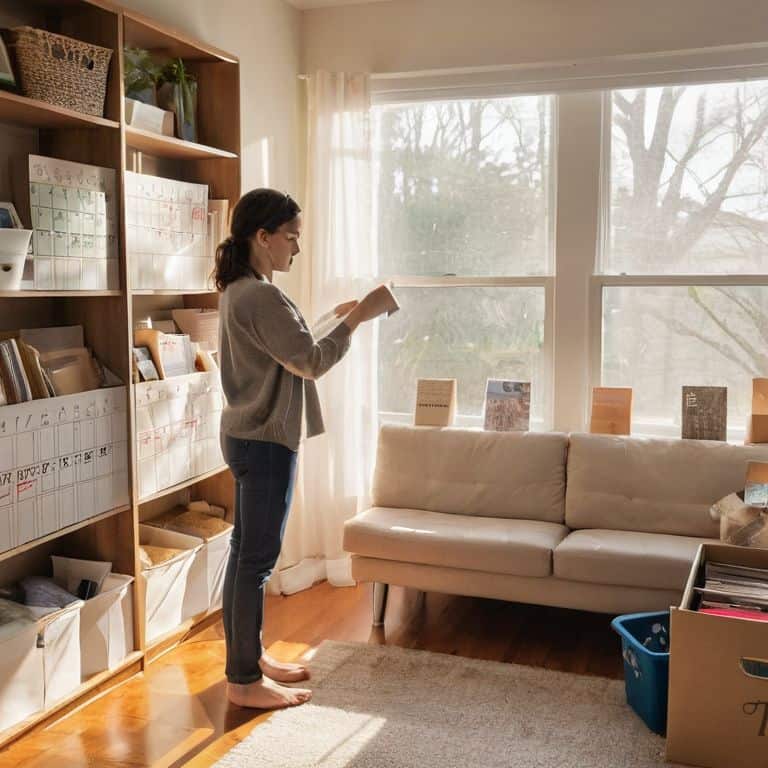I still remember the day I decided to take on a one-month decluttering challenge in my own life – it was the moment I realized that my chaotic closet was a reflection of my chaotic mind. I had tried countless times to tackle the mess, but it wasn’t until I broke it down into manageable steps that I started to see real progress. The common myth that decluttering has to be a massive, overwhelming task is simply not true – with the right approach, anyone can achieve a more organized, peaceful living space.
In this article, I’ll share my personal, no-nonsense approach to a one-month decluttering challenge, including the exact step-by-step framework that worked for me. You’ll learn how to identify the areas of your life that need the most attention, create a realistic plan for tackling them, and maintain your newfound sense of calm and control long after the challenge is over. My goal is to provide you with practical, actionable advice that you can apply to your own life, starting today – no fluffy motivational speeches or unrealistic expectations, just a clear, achievable path to a more organized, clutter-free you.
Table of Contents
Guide Overview: What You'll Need

Total Time: 4 weeks
Estimated Cost: $0 – $20
Difficulty Level: Easy / Intermediate
Tools Required
- Label Maker (optional)
- Markers (various colors)
- Sticky Notes (for reminders)
- Calendar (physical or digital)
Supplies & Materials
- Storage Bins (various sizes)
- Trash Bags (heavy duty)
- Recycling Bins (if needed)
- Donation Boxes (sturdy, 12 inches by 12 inches by 18 inches)
Step-by-Step Instructions
- 1. First, let’s set the foundation for our one-month decluttering challenge by dedicating a few minutes each day to this task. I recommend scheduling it in your calendar, so it becomes a non-negotiable part of your daily routine. Start by gathering some essential supplies like boxes, trash bags, and a marker to label everything.
- 2. Next, we need to assess the situation and understand what we’re up against. Take a walk-through of your home or workspace and make a list of all the areas that need attention. Be honest with yourself – which spaces make you feel overwhelmed or anxious? This list will serve as our roadmap for the next 30 days.
- 3. Now, let’s break it down into smaller, manageable tasks. Divide your list into categories, such as clothing, paperwork, kitchen items, or sentimental objects. This will help you focus on one area at a time, making the task less daunting. For example, you might start with your closet, then move on to your desk, and so on.
- 4. The fourth step is to create a sorting system. Set up three boxes or bins labeled “keep,” “donate/sell,” and “discard.” As you go through each item, ask yourself if it brings you joy, serves a purpose, or is still in good condition. Be ruthless – if you haven’t used it in the past year, it’s likely safe to get rid of it.
- 5. On the 10th day of our challenge, we’ll tackle the paperwork. Gather all your documents, bills, and receipts, and sort them into categories. Consider investing in a file organizer or scanner to digitize your documents, making them easier to access and reducing clutter.
- 6. Around the 20th day, we’ll focus on sentimental items, which can be the most challenging part of decluttering. Handle each item with care, and ask yourself if it sparks joy or serves as a happy reminder. Consider taking photos of items you want to remember but don’t need to keep, and let go of the rest.
- 7. As we near the end of our challenge, it’s time to create habits for maintenance. Schedule regular tidying sessions, whether daily, weekly, or monthly, to maintain your newly organized space. This could be as simple as setting aside 10 minutes each morning to make your bed and put away any clutter.
- 8. Finally, on the last day of our challenge, celebrate your progress and reflect on what you’ve accomplished. Take photos of your newly organized spaces, and treat yourself to something special. Remember, decluttering is a process, and it’s okay to take it one step at a time. By following these steps and staying committed, you’ll be well on your way to a more organized, peaceful life.
Taming Chaos

As we dive into the process of taming chaos, it’s essential to remember that simple decluttering tips for beginners can go a long way. One of the most effective strategies is to start small, focusing on one area or category of items at a time. This helps to build momentum and confidence, making it easier to tackle more significant challenges. By creating a daily decluttering routine, you can make progress without feeling overwhelmed.
When it comes to organizing a cluttered closet, it’s crucial to take a step back and assess the space as a whole. Consider the types of items you need to store, and look for opportunities to purge or donate items that no longer serve a purpose. Decluttering and minimalism benefits can be significant, from reduced stress to increased productivity. By applying these principles to your closet, you can create a more peaceful and functional space.
To maintain a clutter-free home, it’s essential to develop strategies for maintaining a clutter-free home. This might include setting aside time each week to tidy up, or implementing a “one in, one out” policy to prevent clutter from building up in the first place. By being mindful of your habits and making a few simple changes, you can overcome common overcoming decluttering obstacles and keep your space organized and peaceful.
Overcoming Obstacles With Daily Routines
To overcome obstacles, I recommend establishing daily routines that help maintain your space. Start by dedicating 10-15 minutes each day to tidying up, whether it’s wiping down the kitchen counters or putting away clothes. This habit helps prevent clutter from building up and makes it easier to stick to your decluttering goals.
By incorporating these small tasks into your daily routine, you’ll be better equipped to handle larger decluttering tasks and make steady progress throughout the one-month challenge. Remember, it’s all about breaking down overwhelming tasks into manageable steps – and that’s exactly what we’re doing here, one day at a time.
Simple Decluttering Tips for Beginners
As we dive into taming chaos, let’s break it down into manageable bits. For beginners, I recommend starting with small, achievable tasks. Begin by clearing a single shelf or sorting a small box of items. This helps build momentum and confidence. Create a “maybe” box for items that are difficult to decide on – set a deadline to revisit these items, and if you haven’t used or thought about them by then, consider letting them go.
I also suggest implementing the “one in, one out” rule to maintain your newly decluttered space. For every new item that comes into your home or workspace, remove or donate an old one to keep the balance. This simple trick helps prevent clutter from building up again, making it easier to maintain your space and reduce stress.
5 Essential Tips to Succeed in Your One-Month Decluttering Challenge

- Start by creating a flowchart or a mind map to visualize your clutter and identify areas that need the most attention
- Break down your decluttering process into daily tasks, such as dedicating 10 minutes each day to clearing out a small area or tackling one type of item
- Implement the ‘one in, one out’ rule to maintain your newly decluttered space and prevent clutter from building up again
- Use the ‘box method’ where you fill three boxes – one for items to keep, one for items to donate, and one for items to throw away – to make decision-making easier
- Schedule regular ‘maintenance days’ throughout the month to review your progress, adjust your strategy as needed, and stay motivated to reach your decluttering goals
Key Takeaways for a Clutter-Free Life
By committing to a one-month decluttering challenge, you can significantly improve your living and working environments, one step at a time, using practical and manageable steps
Implementing simple decluttering tips and daily routines can help you overcome obstacles and maintain a clutter-free space, even in the face of chaos and disorganization
Through the process of breaking down overwhelming tasks into flowcharts and actionable lists, you can develop the skills and mindset needed to tackle any organizational challenge that comes your way, and achieve a more structured and peaceful life
Embracing the Journey
A one-month decluttering challenge isn’t just about clearing space, it’s about clearing your mind – one deliberate step at a time, until the chaos fades and clarity becomes your new normal.
Sloane Kendrick
Conclusion: Embracing a Clutter-Free Life
As we conclude this one-month decluttering challenge, let’s take a moment to reflect on our progress. We’ve covered the essential steps to tackle clutter, from creating a schedule to implementing daily routines. We’ve also explored simple decluttering tips for beginners and strategies for overcoming obstacles. By following these steps and maintaining a commitment to our goals, we’ve been able to transform our living and working spaces into more organized, peaceful environments. It’s amazing how much of a difference small, consistent changes can make in our overall well-being.
As you move forward, remember that embracing a clutter-free life is a journey, not a destination. It’s about creating systems and habits that support your well-being and productivity. Don’t be too hard on yourself if you encounter setbacks – simply acknowledge the challenge and get back on track. With time and practice, you’ll find that maintaining a clutter-free space becomes second nature, freeing you to focus on the things that truly matter in your life.
Frequently Asked Questions
What are some common pitfalls to avoid when starting a one-month decluttering challenge?
When starting a one-month decluttering challenge, beware of common pitfalls like setting unrealistic goals, not creating a schedule, and keeping ‘maybe’ items. Avoid getting too attached to sentimental objects and don’t try to tackle everything at once. Break it down into smaller tasks and focus on progress, not perfection.
How can I maintain my motivation and momentum throughout the entire month?
To maintain motivation, I recommend tracking your progress on a daily habit chart and rewarding yourself for small milestones. Break down larger tasks into bite-sized chunks, and focus on one area at a time. Celebrate each win, no matter how small, to keep your momentum going throughout the month.
What strategies can I use to deal with sentimental or emotional attachment to cluttered items?
Let’s tackle sentimental clutter together. I recommend creating a ‘Maybe’ box for items that stir emotions. Set a deadline, like 6 months, and if you haven’t used or thought about the item by then, consider letting it go. This helps you distance yourself from emotional attachment and make more rational decisions about what to keep and what to release.
